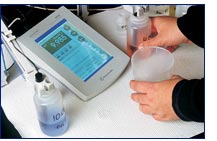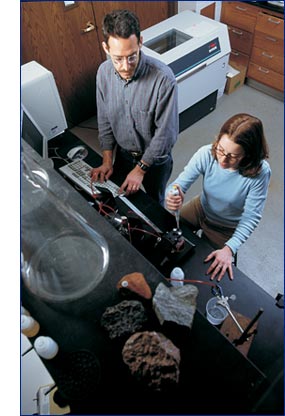|
Bacteria-Water-Rock Interactions
Funded by the National Science Foundation and the American Chemical Society,
Jeremy B. Fein, associate professor of civil engineering and geological
sciences, applies chemical thermodynamics to environmental geomicrobiology
as he studies the biochemical interactions of bacteria, rock, and water. “I
fill a gap between geology and biology,” says Fein. “We’ve
known for a long time that there are bacteria in the ground, even to
great depths under the earth’s surface.” According to Fein,
both geologists and microbiologists have traditionally ignored the
effects of bacteria on contaminant transport in groundwater due to
a lack of understanding each other’s discipline. “The exciting
part about this work is that it bridges the gap between these two disciplines,” says
Fein. “There is a lot of evidence that bacteria interact quite
extensively with the minerals in geologic systems. So we’re studying
important reactions no one has considered before.”
 In the last five years environmental geoscientists have developed qualitative
evidence that bacteria strongly influence how metals and organic solvents
are distributed on the earth’s surface and in groundwater supplies.
For example, if lead is dumped at a particular location, it may be bound
by the bacteria -- meaning that the lead will come out of the solution
and become attached to structures on the cell walls of the bacteria.
Bacteria evolved these structures to absorb nutrients like calcium, magnesium,
and low levels of zinc and iron. But, bacteria cannot differentiate between
those nutrients and metals like lead, copper, cadmium, or uranium. Once
the metal attaches to the bacteria, it becomes as mobile as the bacteria.
If the bacteria move, they carry the contaminants with them. If not,
the pollutants are immobilized. So it is crucial to develop models that
determine the extent of attachment and the mobility of the bacteria in
groundwater aquifers. In the last five years environmental geoscientists have developed qualitative
evidence that bacteria strongly influence how metals and organic solvents
are distributed on the earth’s surface and in groundwater supplies.
For example, if lead is dumped at a particular location, it may be bound
by the bacteria -- meaning that the lead will come out of the solution
and become attached to structures on the cell walls of the bacteria.
Bacteria evolved these structures to absorb nutrients like calcium, magnesium,
and low levels of zinc and iron. But, bacteria cannot differentiate between
those nutrients and metals like lead, copper, cadmium, or uranium. Once
the metal attaches to the bacteria, it becomes as mobile as the bacteria.
If the bacteria move, they carry the contaminants with them. If not,
the pollutants are immobilized. So it is crucial to develop models that
determine the extent of attachment and the mobility of the bacteria in
groundwater aquifers.
Working with researchers from Argonne National Laboratory, and using
the Advanced Photon Source synchrotron, Fein and his team are gathering
information with which to develop models. “Our goal,” he
explains, “is to try to isolate the unique reactions between heavy
metals and bacterial surfaces. We use a specific bacteria species and
place it in contact with a specific groundwater contaminant to determine
how they interact.”
 There are countless species of bacteria in soil and groundwater systems.
Fortunately, the geomicrobiology team doesn’t have to study each
species of bacteria. Instead they are looking for common threads. “One
of the most exciting things we’ve found,” says Fein, “is
that all the bacteria we have tested behave in the same way. There’s
a common structure to the bacterial cell wall that makes predicting bacteria-metal
interactions
much easier.” It’s important to note that these experiments
are the first to quantify the effect of bacteria on aqueous metal, organic
adsorption, and mineral dissolution. In addition, the results can be
used to make groundwater clean-up efforts more efficient and to design
more effective contaminant treatment strategies. There are countless species of bacteria in soil and groundwater systems.
Fortunately, the geomicrobiology team doesn’t have to study each
species of bacteria. Instead they are looking for common threads. “One
of the most exciting things we’ve found,” says Fein, “is
that all the bacteria we have tested behave in the same way. There’s
a common structure to the bacterial cell wall that makes predicting bacteria-metal
interactions
much easier.” It’s important to note that these experiments
are the first to quantify the effect of bacteria on aqueous metal, organic
adsorption, and mineral dissolution. In addition, the results can be
used to make groundwater clean-up efforts more efficient and to design
more effective contaminant treatment strategies.
Fein works with two graduate students and approximately four undergraduates
each year. He believes the size of the College of Engineering is a benefit
for graduate students, but perhaps more so for undergraduates. “The
undergraduates who work in the Environmental Geochemistry and Geomicrobiology
Laboratory participate in independent research, in much the same manner
as do the graduate students,” explains Fein. “It is one of
the tangible advantages of being at a top research university as an undergraduate.” In
fact, as a result of their lab activities, most of the undergraduates
under Fein’s supervision have been listed as authors in research
publications. |
|
Highlighting Undergraduate Research
 Traditionally an undergraduate’s opportunities for hands-on
research are quite limited. That’s not the case in the College
of Engineering, especially in the Department of Civil Engineering
and Geological Sciences. In addition to faculty, visiting scholars,
and graduate students, a total of 21 undergraduates work in the department’s
research labs. Jonathan Roller, a senior majoring in environmental
geosciences, is one of them. Traditionally an undergraduate’s opportunities for hands-on
research are quite limited. That’s not the case in the College
of Engineering, especially in the Department of Civil Engineering
and Geological Sciences. In addition to faculty, visiting scholars,
and graduate students, a total of 21 undergraduates work in the department’s
research labs. Jonathan Roller, a senior majoring in environmental
geosciences, is one of them.
In fact, he’s worked in two different labs over the last three
semesters. During his junior year, Roller worked with Clive R. Neal,
associate professor of civil engineering and geological sciences
and director of Notre Dame’s Inductively Coupled Plasma-mass
Spectrometry Facility. Roller’s main responsibility was to
prepare samples for testing.
This year he’s working with Jeremy B. Fein, associate professor
of civil engineering and geological sciences, and Peter Wightman,
a doctoral candidate, in the Environmental Geochemistry and Geomicrobiology
Laboratory. Roller spends approximately three hours every day in
the lab. “We’re testing a specific bacteria -- Bacillus
subtilis -- varying the range of pH and the amount of electrolyte
in the solution, then adding a concentration of heavy metal to determine
how the pH and electrolyte concentrations affect the level of metal
adsorbed onto the surface of the bacteria,” said Roller. “It’s
a very strict regimen. You have to be in the lab exactly 24 hours
after you initially feed the bacteria or the results could be skewed.”
Roller has enjoyed the experience so much it’s encouraged him
to apply to graduate school. The biggest benefit to working in the
labs, he says, is two-fold. “You see the data firsthand so
it becomes more than something in a textbook. And, I think it gives
students an excellent idea of what graduate school is about. My experience
here as an undergraduate is the main reason I will be pursuing a
graduate degree.” |
|
|
 |
 |
 |
 |
 |
| |
|
|

